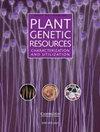哥伦比亚昆迪纳马卡藜麦(Chenopodium quinoa wild .)的遗传多样性
IF 0.7
4区 生物学
Q3 PLANT SCIENCES
Plant Genetic Resources: Characterization and Utilization
Pub Date : 2023-03-06
DOI:10.1017/s1479262123000060
引用次数: 0
摘要
藜麦(Chenopodium quinoa W.)是南美洲的一种,具有特殊的营养成分和广泛的农业气候适应性。它具有很大的遗传和表型变异性,但在哥伦比亚,利用其巨大的遗传和生产潜力的遗传改良方案很少。在Cundinamarca,农民选择了一些适应的基因型。利用8个ISSR标记,对来自Cundinamarca的Blanca de Jericó、Blanca Subachoque、Aurora、Púrpura和Tunkahuan的36个基因型进行了评价。在相似水平为0.40的Nei-Li系数分析中,根据草酸盐的背景遗传和颜色将群体分为3个群体。多态性位点的比例大于90%。杂合度平均值为0.32,考虑到被评价种质所经历的选择过程,这是一个较低的杂合度。我们发现中度遗传分化(Fst = 0.23)。分子方差(AMOVA)分析显示,组间变异率(23%)高于组间变异率(77%)。结果揭示了种群内的多样性,这表明农民在他们的农场内应该经历一个更严格的种子选择过程。研究结果表明,ISSR标记对藜麦品种的亲缘关系、多态性和遗传多样性的评价是有效的。本研究报告的遗传鉴定结果对指导哥伦比亚藜麦种子品质育种具有重要意义。本文章由计算机程序翻译,如有差异,请以英文原文为准。
Genetic diversity of quinoa (Chenopodium quinoa Willd.) from Cundinamarca, Colombia
Chenopodium quinoa W. is a species of South America with an exceptional nutritional content and wide agroclimatological adaptation. It has great genetic and phenotypic variability, however in Colombia there are few genetic improvement programmes that take advantage of its great genetic and productive potential. In Cundinamarca there are some adapted genotypes which have been selected by farmers. We evaluated 36 genotypes of Blanca de Jericó, Blanca Subachoque, Aurora, Púrpura and Tunkahuan from Cundinamarca, using eight ISSR markers. The analysis by the coefficient of Nei-Li at the level of similarity of 0.40 divided the population into three groups according their background genetic and the colour of oxalates. The percentage of polymorphic loci was higher than 90%. The average value of heterozygosity was 0.32, which is low given the selection processes that the evaluated germplasm has undergone. We found moderate genetic differentiation (Fst = 0.23). The analysis of molecular variance (AMOVA) showed higher variation (77%) groups than among groups (23%). The results revealed intra-population diversity, which suggests that farmers within their farms should undergo a more rigorous seed selection process. Our results demonstrate that ISSR markers are useful and powerful to assess the genetic relationships, polymorphism and genetic diversity of quinoa cultivars. The genetic characterization results reported in the present study will be promising for guiding the breeding of quinoa seed quality in Colombia.
求助全文
通过发布文献求助,成功后即可免费获取论文全文。
去求助
来源期刊

Plant Genetic Resources: Characterization and Utilization
Agricultural and Biological Sciences-Agronomy and Crop Science
CiteScore
2.80
自引率
0.00%
发文量
29
审稿时长
>12 weeks
期刊介绍:
Plant Genetic Resources is an international journal which provides a forum for describing the application of novel genomic technologies, as well as their integration with established techniques, towards the understanding of the genetic variation captured in both in situ and ex situ collections of crop and non-crop plants; and for the airing of wider issues relevant to plant germplasm conservation and utilisation. We particularly welcome multi-disciplinary approaches that incorporate both a technical and a socio-economic focus. Technical aspects can cover developments in technologies of potential or demonstrated relevance to the analysis of variation and diversity at the phenotypic and genotypic levels.
 求助内容:
求助内容: 应助结果提醒方式:
应助结果提醒方式:


